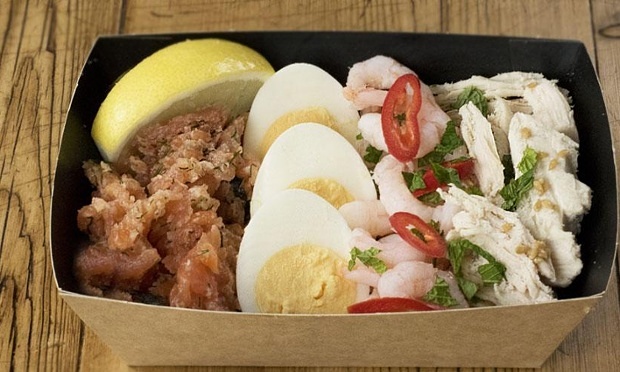


PROTEIN boxes. Protein shakes. Protein waffles, pancakes, salads. Not since the Atkins Diet has protein been so idolised. Like the comeback of a well-loved boy band, the nutrient has had a makeover and returns, presented to us as an ingredient in its own right.
High-street food chains including Pret a Manger and Pod are now placing the nutrient rather than the ingredient centre-stage – and no need to know what foods contain which nutrients, they are telling us upfront: “This is protein.” “Our mission is to offer a balanced menu, so our in-house nutritionist pulled out the key food groups to profile,” explains Pod’s marketing director Meg Ellis. “Hence the name Protein Box.” Pret a Manger’s group director of food, Caroline Cromar, says they are catering to demand: “High-protein diets have been a big trend for some time, so having protein in the product name makes it easy for customers to identify them as a good source.” The chain has had an Egg and Spinach Protein Pot and a Veggie Sushi Protein Pot on sale since 2013, at least giving you an idea of what the source of the nutrient might be.
This isn’t the case elsewhere, where the nutrient is far more important than the food containing it. Those mega-tubs of powders so beloved of 16-year-old boys are mainstream now, with several gyms and cafes transforming them into more palatable formats. “There’s a higher demand for healthy, nutrient-dense shakes that incorporate a soya, rice or pea protein,” says Dan Thomson, founder of juice and fitness company Supernatural, which sells protein shakes. Frame, the chain of gyms, sells protein pancakes in its King’s Cross cafe in London, and C-Press, an organic food company that runs the cafe for Core Collective gym, offers protein waffles and protein bites. What food is this protein coming from? “We use hemp protein as it’s vegan, so it can be consumed by the majority of people,” says Zoe Stirling, C-Press’s nutritionist. “But many customers still don’t make the connection that hemp is a form of protein. So we call it ‘protein’ rather than ‘hemp’.”
In the case of hemp, and in the environment of gyms and health cafes, you can see why protein may be a more appealing label, but I’m a bit baffled by restaurants that place the nutrient above the ingredient. The Good Life Eatery in Chelsea has a dedicated section on its menu for extra proteins, and The Black Penny in Covent Garden offers you a choice of proteins to accompany your salad, rather than listing what the foods containing the proteins might be. “We feel that it is a much healthier way to promote our offerings,” explains Zoe Notley, the restaurant’s general manager. “Instead of listing the protein as a piece of chicken, which is not as enticing, we wanted to appeal directly to our customers who gravitate towards healthier lifestyle choices.” Which raises the question: in what world is “protein” more enticing than “chicken”? Not in a world where people love food, I’d argue.
And of course, protein’s promotion to ingredient status doesn’t apply to other, less trendy, nutrients – some nutrients are more equal than others. You won’t see toast with butter on a menu as “carbs and fat”, because, as Stirling points out: “Carbs and fats have both been demonised in some shape or form and so we don’t think of them in the same way.”
But we need all of these things, in appropriate proportion. Are these companies helping by simplifying things, or contributing to our ignorance about what we’re actually eating? Does it matter what food you actually get your protein from, or is it better to know that you’re getting your recommended daily requirement, however it comes? -Guardian.com